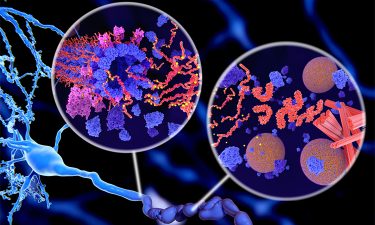Drug Target Review’s top content picks from 2022
Posted: 13 December 2022 | Izzy Wood (Drug Target Review), Ria Kakkad (Drug Target Review) | No comments yet
In this article, Drug Target Review’s Izzy Wood and Ria Kakkad share some of the most ground-breaking moments from drug discovery this year.

As we are approaching 2023, the team at Drug Target Review are feeling very reflective.
2022 marked the 10th anniversary of Jennifer Dounda and Emmanuelle Charpentier publishing a trailblazing paper on CRISPR-Cas9, which lead them to win the Nobel Prize in Chemistry.
This year has also seen trends transition away from a heavy COVID-19 focus, bringing attention to new and innovative research in genomics, HIV and the latest on Alzheimer’s disease.
In this article, Editorial Assistants, Izzy Wood and Ria Kakkad are taking the opportunity to highlight some of the most pivotal moments of the year.
First Izzy takes the lead, sharing her highlights of 2022’s cutting-edge research which includes advances in CRISPR, Alzheimer’s and antimicrobial resistance.
CRISPR drug target discoveries
Scientists and researchers investigating CRISPR-based techniques are finding promising therapeutic possibilities that with more research could be used to inform drug development. In an article, I listed five of the most recent target discoveries made using this technology.
One I found particularly interesting was CRISPR-based microbiome editing which allowed researchers from North Carolina State University (NC State), US, prevent bacterial defences and make selective changes to a targeted bacterium, even when other bacteria are in proximity.
In their study, the team deployed two different engineered bacteriophages to deliver CRISPR-Cas payloads for targeted editing of E. coli: first in a test tube and then within a synthetic soil environment created to mimic soil.

2022 marked the 10th anniversary of Jennifer Dounda and Emmanuelle Charpentier publishing a trailblazing paper on CRISPR-Cas9, which lead them to win the Nobel Prize in Chemistry.
Both the engineered bacteriophages – T7 and lambda – successfully found and then delivered payloads to the E. coli host on the lab bench. These payloads expressed bacterial fluorescent genes and manipulated the bacterium’s resistance to an antibiotic. The team used lambda to deliver a so-called cytosine base editor to the E. coli host.
Professor Todd Klaenhammer, Bioprocessing and Nutrition Sciences at NC State, added: “We use a bacterial virus, a bacteriophage, to deliver CRISPR to bacteria, which is ironic because bacteria normally use CRISPR to kill viruses.”
“We used a base editor here as a kind of programmable on-off switch for genes in E. coli. Using a system like this, we can make highly precise single-letter changes to the genome without the double-strand DNA breakage commonly associated with CRISPR-Cas targeting,” said Matthew Nethery, a former NC State PhD student and lead author of the study.
“We see this as a mechanism to aid the microbiome. We can make a change to a particular bacterium and the rest of the microbiome remains unscathed,” Raldolphe Barrangou said. “This is a proof-of-concept that could be employed in any complex microbial community, which could translate into better plant health and better gastrointestinal tract health.
“Ultimately this study represents the next chapter of CRISPR delivery – using viruses to deliver CRISPR machinery in a complex environment.”
You can read the rest of the CRISPR-based techniques here.
Is hydroquinine the answer to antimicrobial resistance?
I recently spoke to Dr Robert Baldock, Research Scientist at the University of Portsmouth, UK, about compound hydroquinine and how it could be used as an effective weapon against a pathogen that causes serious infections in humans.
“It was really exciting to see that hydroquinine showed killing activity against a range of clinically relevant bacteria
The scientists discovered how hydroquinine inhibits and kills a bacteria with antimicrobial resistance that causes serious illness or in some cases death. It significantly alters the expression levels of virulence factors Pseudomonas aeruginosa: a bacteria, often found in hospital patients, that can lead to infections in the blood after surgery.
The team explored the molecular responses of Pseudomonas aeruginosa strains to hydroquinine. They did this by looking at which genes were switched on and which were switched off in response to the drug.
“If we know that this drug is working in a really unique or different way then it firstly explains why it is active on these drug-resistant cells, but it also means that you can potentially look at combining it with other existing antibiotics to make them more effective,” Baldock commented
Baldock answered: “It was really exciting to see that hydroquinine showed killing activity against a range of clinically relevant bacteria (including a multidrug resistant strain of Pseudomonas aeruginosa)”.
“We uncovered that hydroquinine could reduce the motility and communication ability of Pseudomonas aeruginosa both drug sensitive and multidrug resistant strains. Our new findings could be potentially used in developing alternative antibacterial compounds in future”.
Targeting tau – chasing a treatment for Alzheimer’s
Alzheimer’s disease remains one of the largest challenges for the global ageing population. Drug Target Review’s Victoria Rees reviewed some of the latest research, highlighting how progress has been made in understanding tau as well as how to potentially target this protein as a therapeutic strategy against Alzheimer’s.
Scientists around the world are focused on finding a cure for this condition, with the tau protein featuring in many studies. Consequently, tau is one of the main targets for this disease and finding new ways to target this protein could aid in the development of new Alzheimer’s treatments.
Research on tau
Before researchers can effectively target this protein, certain aspects of it must be understood. One recent study from Flinders University, Australia, revealed how the tau protein is involved in normal learning processes in the healthy brain – potentially providing a focal point for future drug therapies.

Tau is one of the main targets for this disease and finding new ways to target this protein could aid in the development of new Alzheimer’s treatments.
By removing and reintroducing the tau protein in brain cells, the researchers were able to attribute changes in the receptors’ behaviour to changes in tau, which they say may become focal points for future drug therapies.
Understanding tau in Alzheimer’s
Scientists are also focused on how to understand the ways that tau acts in relation to Alzheimer’s. Knowing how and why tau tangles can form could help to reveal potential treatments that target this process.
Another team from Karolinska Institutet in Sweden used three-dimensional (3D) imaging technology to comprehensively characterise a part of the brain that shows what may be the earliest accumulation of tau protein. The results could aid in more precise neuropathological diagnosis of Alzheimer’s disease at an early stage.
Targeting tau
In another study from Okinawa Institute of Science and Technology (OIST), Japan, researchers showed how excess tau impairs signalling between neurons in the brains of mice.
According to the scientists, this could open new pathways for treating the symptoms and even halting the progression of Alzheimer’s disease. The researchers from this study highlight that many scientists focus on the impact of visible neurofibrillary tangles that are a hallmark of Alzheimer’s, but that it is the invisible levels of soluble tau that correlate most closely with cognitive decline.
Ria brings you her highlights on developments in genomics, women’s health and HIV vaccines.
Inclusive data in genomics
Genomics studies has been and always will be a huge part of drug discovery research, for example, researchers use genomic analysis to understand genetic variants related to different diseases.
Despite genomics being an important aspect of life sciences, most participants of research have been of European descent. Earlier this year, I spoke to Assistant Professor Lindsay Fernández-Rhodes who argued that genetic-based precision medicine grows, this diversity gap means those unrepresented in data may lack access to medical care that could reduce growing diseases among specific groups, particularly minorities.
Integrating genomic data from different ancestries reduces bias in predicting disease risk
READ MORE HERE
Her team had examined genomic data from more than 70,000 Hispanic/Latino participants and were able to identify 42 previously unidentified regions of the human genome related to BMI, height, and waist-to-hip ratio.
Fernández-Rhodes argued that “without leveraging the diversity in human populations, without combining all of this data, those are regions that would have never been discovered.”
You can read the full article here.
Drug development for endometriosis
According to the World Health Organization (WHO), around 10 percent of women and girls of reproductive age suffer from endometriosis (ENDO). It is a disease where endometrial-type tissue attaches to and develop lesions in regions of the body outside of the uterine cavity, generally within the lower abdominal region.
For International Women’s Day 2022 and Endometriosis Awareness Month, I interviewed Dr Paulina Nunez- Badinez about her pre-clinical research of pain related to ENDO, and why there is a lack of understanding and awareness around this long-term condition.

WHO found around 10 percent of women and girls of reproductive age suffer from ENDO
She argued that therapeutic development for ENDO has been slow due to a restricted understanding of the disease and a limited translatability of the available animal models. This is an issue related to many diseases and illnesses.
She also highlighted socioeconomic factors that make research difficult:
“On one hand, only few pharmaceutical companies are still investing in women’s health. On the other hand, payors (at least in Europe) are not prepared to pay prices for this non-life-threatening disease affecting women.”
You can read the full interview here.
Progress in HIV research
HIV is still a huge focus in research within the drug discovery industry. According to WHO, 650,000 people died of HIV-related illness around the globe in 2021.
This year, we saw many pre-clinical studies that successfully improved immune responses to HIV in animal models. However, researchers are yet to find a vaccine that can succeed in pivotal trials and help patients.
Yet, researchers are still optimistic. A team of US scientists from Scripps Research, the International AIDS Vaccine Initiative (IAVI), the Ragon Institute and Moderna have made critical advances in developing an effective vaccine against HIV.
The research highlighted the first steps in a vaccine approach that aims to prompt the creation of broadly neutralising antibodies (bnAbs) — antibodies that are broad enough to fight and protect against many different variants of a virus. The team identified the most promising bnAbs and the human genes needed to make them, as well as designing protein and mRNA vaccine candidates to begin bnAb creation and verifying the vaccine candidates.
“Our two studies describe a collaborative effort to genetically and structurally understand bnAbs, and ultimately ‘reverse engineer’ vaccines to elicit these bnAbs,” said senior author.
“HIV has remained one of the most difficult viruses to protect against because of its natural ability to quickly mutate and evade capture from the immune system. Working closely together across scientific disciplines and institutions, our team’s findings mark a crucial step forward in overcoming these historic hurdles and creating an effective HIV vaccine.”
The researchers are continuing refine their vaccine approach and test it in additional models with the intent to ultimately enter the clinic for human trials.
You can read more on this study here.
The Drug Target Review team hopes you enjoyed our content highlights from this year.
Look out for our 2022 wrap-up newsletters in the coming weeks, where Ria and Izzy will share top content picks from the year. Subscribe to our email newsletters here.
We look forward to bringing you even more exciting drug discovery content in 2023!
About the authors
 Izzy Wood is an Editorial Assistant at Drug Target Review
Izzy Wood is an Editorial Assistant at Drug Target Review
 Ria Kakkad is an Editorial Assistant at Drug Target Review
Ria Kakkad is an Editorial Assistant at Drug Target Review
Related topics
CRISPR, Disease Research, Drug Discovery Processes, Gene Testing, Gene Therapy, Genome Editing, Genomics, Neurosciences, Vaccine
Related conditions
Alzheimer’s disease, antibiotic resistance, endometriosis, HIV







